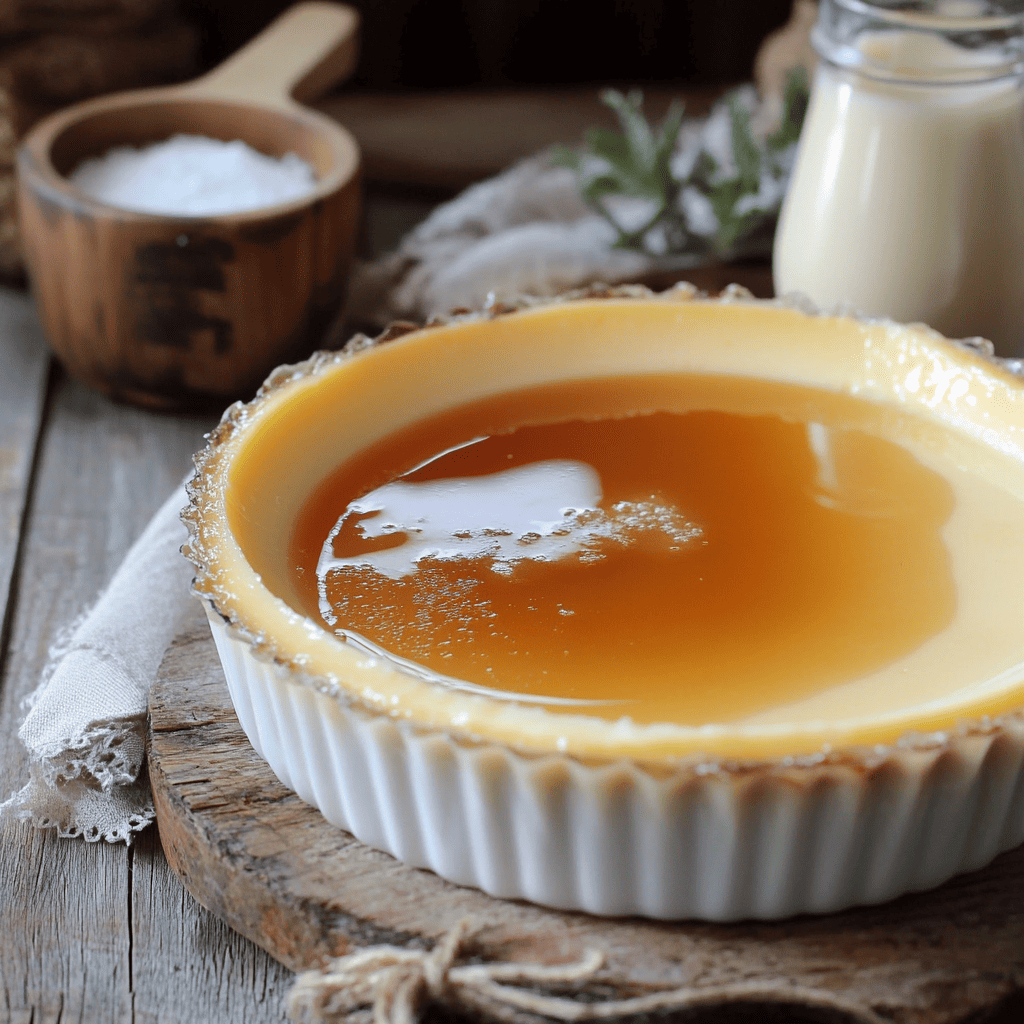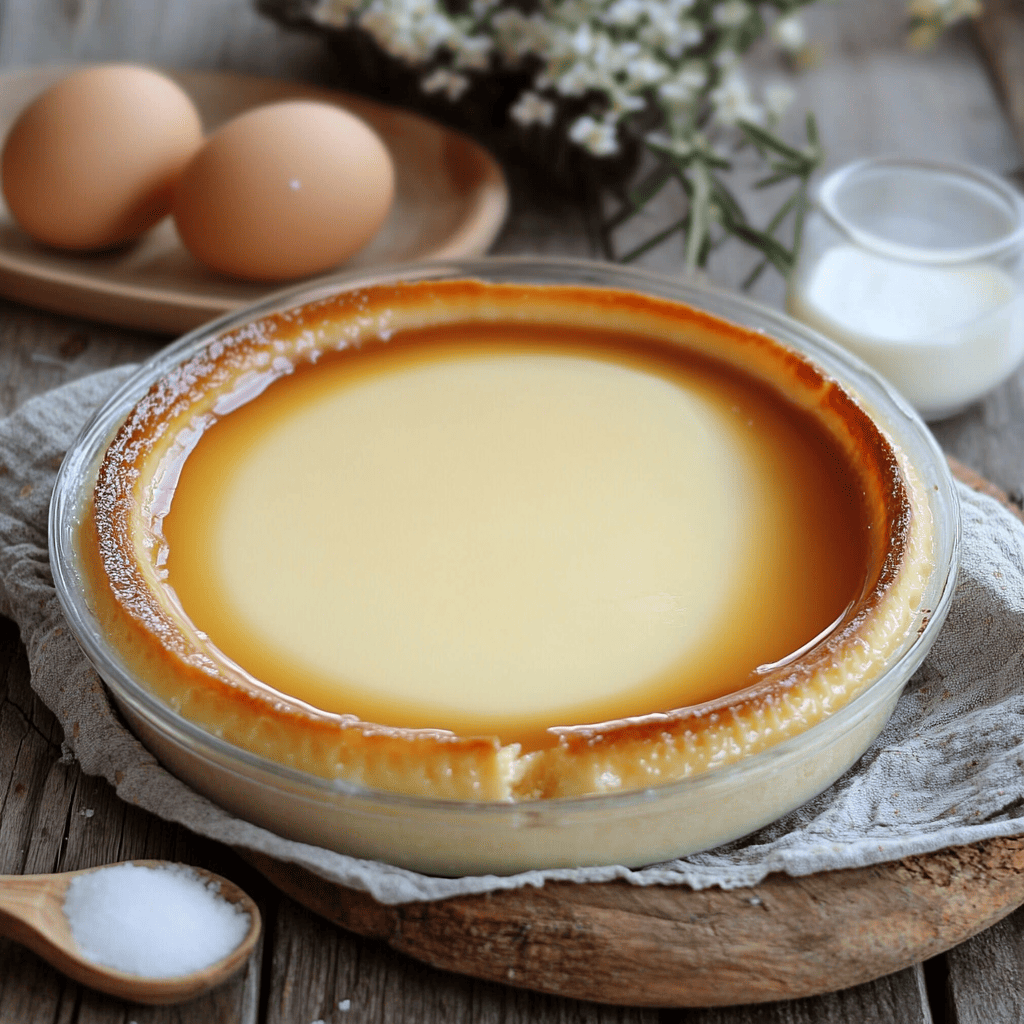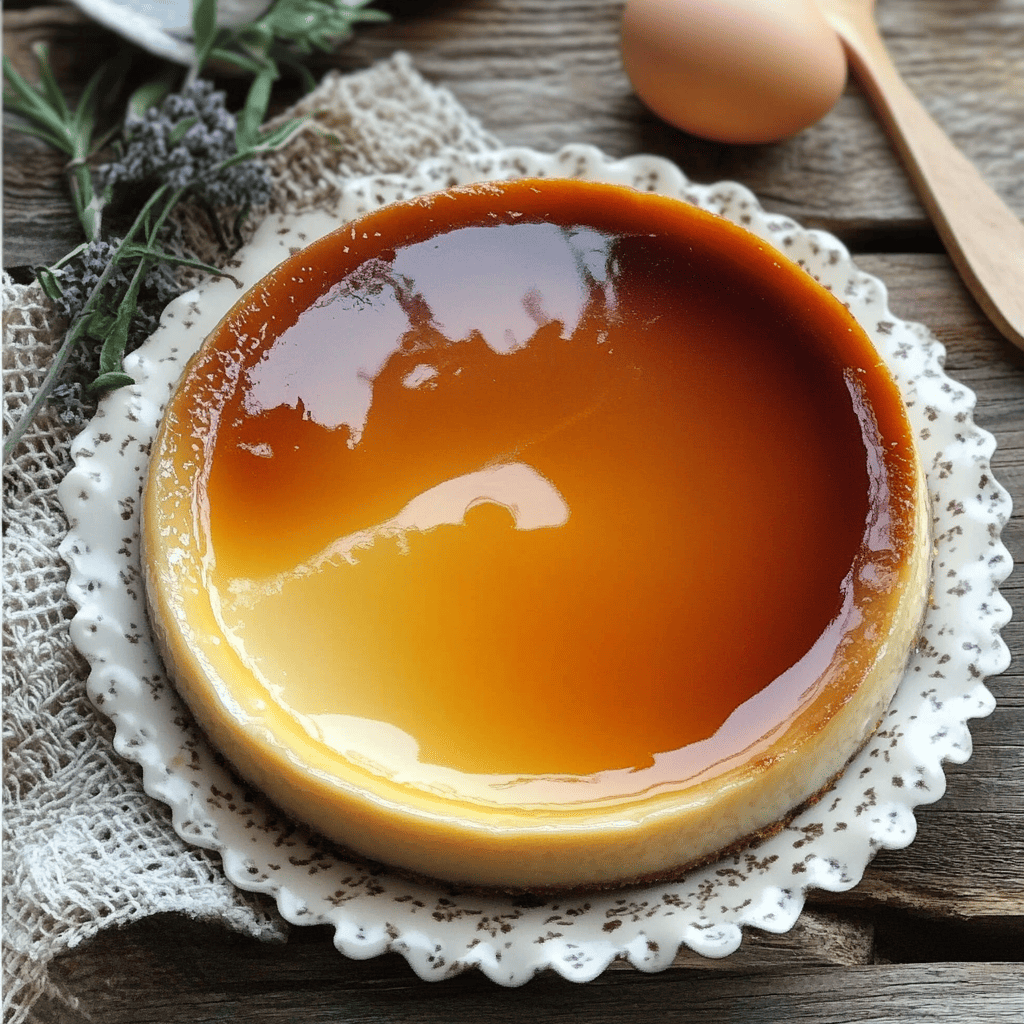Cornstarch Flan
Introduction
Cornstarch flan is a creamy and delicate dessert, appreciated for its smooth texture and subtle sweetness. Unlike traditional flan, which is made with whole eggs and cooked in a bain-marie, this version uses cornstarch as a thickener, achieving a smooth and even consistency without the need for prolonged baking. This dessert is very popular in Latin America and Spain, where it is often served with caramel or fresh fruit.
History of Cornflour Flan
Flan is a dessert with a long history dating back to the Roman Empire. However, the cornstarch version is more recent and emerged as a simpler alternative to the traditional flan made with eggs and cream.
Maizena , or cornstarch, was introduced into European and Latin American cuisine in the 19th century, allowing for the creation of lighter, more digestible desserts. Today, this recipe is very popular in countries like Brazil, Argentina, Mexico, and Spain, where it’s a classic at family gatherings and celebrations .
Detailed history of Flan and its evolution to Cornflour Flan
Flan is one of the oldest desserts in the world, with a history dating back more than 2,000 years . Its evolution has spanned different cultures, adapting and perfecting itself until it became the creamy, sweet dessert we know today.
Origins in Ancient Rome
Flan originated in Ancient Rome , when the Romans began experimenting with eggs in various preparations. They discovered that beaten eggs could set when cooked with milk and honey, creating a pudding-like consistency. This early version of flan was more of a savory dish, made with ingredients like pepper and herbs.
With the expansion of the Roman Empire, the flan recipe spread throughout Europe, especially in Spain and France , where sweet ingredients such as sugar and vanilla were added.
Middle Ages: Flan with caramel
During the Middle Ages , the Arabs introduced a key culinary technique to Europe: caramelizing sugar . It was during this period that flan began to be served with a layer of liquid caramel on top, giving it the sweet, characteristic touch it has today.
During this time, flan became a popular dessert in monasteries and noble houses, thanks to the abundance of eggs and milk in the diet of the time. It was also a perfect choice for the Lenten season, when meat consumption was restricted.
Origin and Evolution of Flan
Flan is a dessert with a history dating back to ancient Rome, where it was prepared with eggs, milk, and honey. With the expansion of the Roman Empire, the recipe spread throughout Europe and evolved over time. During the Middle Ages, the Arabs introduced caramel into its preparation, giving rise to the version we know today.
Cornflour flan is a modern variation that emerged in the 19th century, when cornstarch became popular as a thickener in cooking. This version is lighter and easier to make, as it doesn’t require an oven or a double boiler, making it an ideal alternative for those looking for a quick and delicious recipe.
Expansion of Flan in Latin America
With the arrival of the Spanish in America, flan was introduced to the New World , where it quickly adapted to local ingredients. In Mexico, for example, flavors like coconut, cajeta (dulce de leche), and cheese began to be added. In countries like Argentina and Chile, flan served with dulce de leche became popular , an irresistible combination.
Over the centuries, each country has developed its own version of flan, with different textures and preparation methods.
The Birth of Cornflour Flan
Maizena flan is a modern variation of the traditional flan that emerged in the 19th century , when corn starch (known as Maizena ) became popular in cooking as a thickener.
This version doesn’t require an oven or a double boiler, as the cornstarch allows the mixture to thicken when heated on the stovetop. This makes it easier and quicker to prepare, while retaining the creamy texture of the original flan.
Cornstarch flan is very common in Latin American and European homes , as it allows for the addition of various flavors such as chocolate, coffee, coconut, and fruit. Its popularity has grown due to its practicality and the possibility of making sugar-free or egg-free versions, adapting to different diets.
A Dessert with History and Evolution
Flan has come a long way from its invention in Ancient Rome to modern versions like cornstarch flan. It has evolved from a savory dish to a sweet caramel dessert, evolving with every culture and region of the world.
Today, cornstarch flan is a perfect option for those looking for a quick, easy, and delicious dessert that doesn’t require an oven. It’s a testament to how cuisine evolves and adapts to modern times without losing its essence.

Ingredients and Preparation
Ingredients
- 1 liter of milk
- 100 g of sugar
- 4 egg yolks
- 3 tablespoons of cornstarch
- 1 teaspoon of vanilla essence
- 1 pinch of salt
Step-by-step preparation
- Heat the milk and sugar
- In a saucepan, heat the milk with the sugar over medium heat.
- Stir to completely dissolve the sugar, but do not let the milk boil.
- Prepare the cornstarch
- Dissolve the cornstarch in approximately 50 ml of cold milk and mix well to avoid lumps.
- Beat the egg yolks
- In another bowl, beat the egg yolks with a pinch of salt until smooth.
- Add the ingredients
- Add the dissolved cornstarch to the hot milk, stirring constantly.
- Then, add the beaten egg yolks and continue mixing over low heat until the mixture thickens.
- Add vanilla and chill
- Once the mixture has acquired a creamy texture, add the vanilla essence and mix well.
- Pour into individual molds and let cool to room temperature.
- Refrigerate and serve
- Place the flan in the refrigerator for at least 2 hours before serving.
- Decorate with liquid caramel, fresh fruit or whipped cream.

Questions to Reflect On
- What is the difference between a traditional flan and a cornstarch flan in terms of texture and preparation?
- Why is it important to dissolve cornstarch in cold milk before adding it to the hot mixture?
- What other flavors could be added to innovate this recipe? (Chocolate, coffee, coconut, etc.)
- How can this recipe be made healthier without losing its flavor?
- Why is refrigerator rest time essential for achieving the perfect flan texture?
Questions to Reflect on Cornstarch Flan
- What is the main difference between traditional flan and cornstarch flan in terms of preparation and texture?
- How did Roman and Arab cuisine influence the evolution of flan as we know it today?
- Why do you think cornstarch flan has become so popular compared to other versions?
- What advantages does using cornstarch have in this recipe compared to other thickeners or cooking techniques?
- What are some interesting variations you can make with cornstarch flan to give it a unique touch?
- What impact did colonization have on the expansion of flan throughout Latin America?
- How does the caramel layer influence the perception of the flavor and texture of flan?
- What ingredients could you substitute to make a healthier version or one suitable for people with dietary restrictions?
- What’s the secret to making cornstarch flan with a smooth, lump-free texture?
- What drinks or accompaniments do you recommend to enhance the flan’s flavor even more?
Variations of Cornstarch Flan
Cornflour flan is very versatile and can be customized with different flavors and combinations. Some of the most popular versions include:
Chocolate flan: Cocoa powder or melted chocolate is added to the mixture for a more intense flavor.
Coffee flan: Instant coffee or espresso is added to the preparation for a more sophisticated touch.
Coconut flan: Part of the milk is replaced with coconut milk, and grated coconut is added for a special texture.
Orange or lemon flan: Citrus zest and juice are added for a fresh and aromatic touch.
Sugar-free flan: For a healthier version, sweetener can be used instead of sugar and skim milk.
Tips for a Perfect Flan
Avoid lumps: Make sure to dissolve the cornstarch well in cold milk before adding it to the hot mixture.
Stir constantly: To achieve a creamy texture, stir constantly over low heat until thickened.
Use quality ingredients: Natural vanilla and good milk will make a difference in the flavor.
Proper cooling: Let the flan rest in the refrigerator for at least 2 hours for a better texture.
Curiosities about Flan
In France, flan is known as “crème caramel” and is a very refined dessert.
In Mexico and other Latin American countries, flan is a typical dessert at parties and family celebrations.
In some versions, it is mixed with cream cheese for an even smoother and creamier texture.
Cornstarch is not only used in flans, but also in soups, sauces, and pastries to thicken and give body to the preparations.
Texture and flavor
Cornstarch flan has a smooth, silky texture that’s slightly denser than traditional flan , thanks to the use of cornstarch. Its flavor is sweet, delicate, and creamy , with notes of vanilla and milk that make it comforting and very pleasant to the palate.
Consumer context
This dessert is common in Latin American and European homes , served primarily as a family dessert or at festive gatherings. Its simple preparation makes it ideal for occasions when you’re looking for something sweet yet affordable and quick. It’s perfect cold, after a hearty meal , or even as a snack.
Visual appearance
Cornflour flan has a pale yellow or creamy beige color , with a smooth, shiny surface. It is often topped with liquid caramel , which enhances its appearance and flavor. It can be garnished with fruit, whipped cream, or shredded coconut.
Curiosities
- Cornstarch is a thickener commonly used in cooking, and allows you to make flan without the need for an oven or a bain-marie .
- It is a dessert that does not require an oven , ideal for people with time or equipment limitations.
- It is known in some countries as “ quick flan ” or “ pot flan ” due to its direct cooking method over the fire.
Estimated nutritional value per serving (1/8 approx. 130 g)
- Calories: 180–220 kcal
- Protein: 4–6 g
- Fats: 5–8 g
- Carbohydrates: 28–32 g
- Sugars: 20–25 g
- Calcium: Moderate (thanks to milk)
Additional benefits and interesting facts
- Containing milk and egg yolks , it is a source of high-quality protein, calcium and vitamins A and D.
- Ideal for people who cannot consume gluten, since cornstarch is naturally gluten-free .
- It can be nutritionally enriched with plant-based milk, less sugar, or natural sweeteners for a healthier version.
- It is an excellent way to take advantage of basic ingredients that are almost always at home .

Conclusion
Cornstarch flan is a quick and easy alternative to traditional flan, perfect for those looking for a creamy, no-bake dessert. Thanks to the cornstarch, a smooth, even texture is achieved in a short time. Its versatility also allows it to be adapted to different flavors and toppings, such as caramel, fresh fruit, or even chocolate.
This dessert is an affordable, easy, and delicious option , perfect for any occasion. Its success lies in its ease of preparation and its comforting flavor, which delights all generations.
Cornstarch flan is an excellent alternative to traditional flan, as it’s easy to make, requires no oven, and can be customized with different flavors. It’s a versatile, delicious dessert perfect for any occasion. Its creamy texture and sweet flavor make it an ideal choice for those looking for a hassle-free homemade dessert.
Cornstarch flan is a delicious evolution of the traditional flan that has adapted to modern times. Its history, which began in Ancient Rome , has spanned different cultures, acquiring Arab, European, and Latin American influences until it has become a classic dessert around the world.
The addition of cornstarch as a thickener instead of eggs and a double boiler has made this version more accessible, quick, and easy to prepare. Its creamy texture and mild flavor make it an ideal choice for those looking for a hassle-free homemade dessert.
Además, el flan de Maizena es extremadamente versátil, permitiendo la incorporación de sabores como café, chocolate, coco, frutas, almendras y más, lo que lo convierte en un postre que se puede personalizar según los gustos de cada persona. También es una excelente alternativa para quienes buscan opciones sin huevo o sin gluten.
A lo largo de los años, el flan ha sido un símbolo de tradición, hogar y confort, presente en celebraciones, reuniones familiares y momentos especiales. Su sencillez no le resta importancia, sino que lo convierte en un postre atemporal que ha logrado mantenerse vigente a lo largo de los siglos.
En definitiva, el flan de Maizena es una opción deliciosa, práctica y con historia, ideal para quienes desean disfrutar de un dulce clásico con un toque moderno. ¡Anímate a prepararlo y a experimentar con nuevas versiones!

